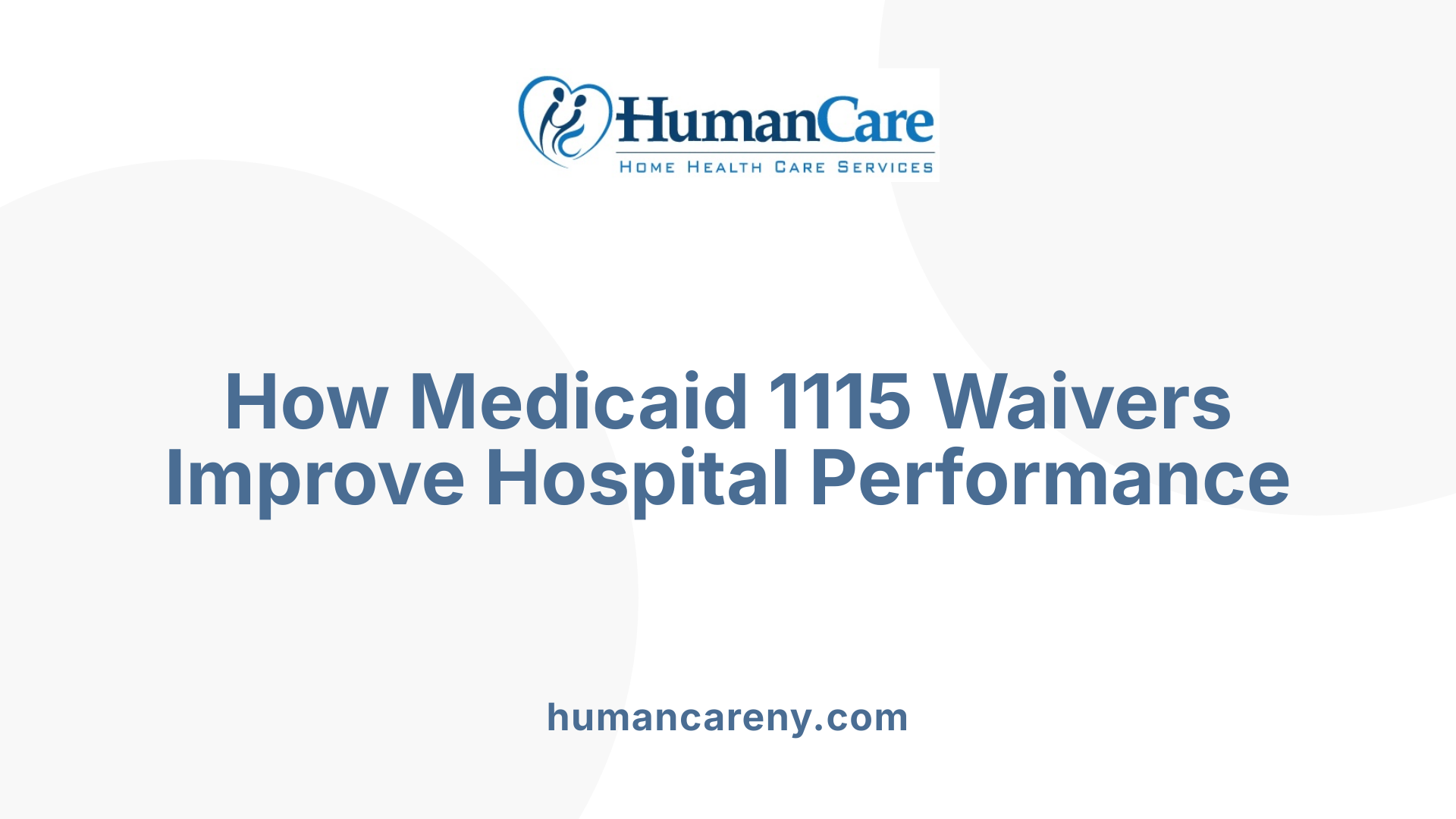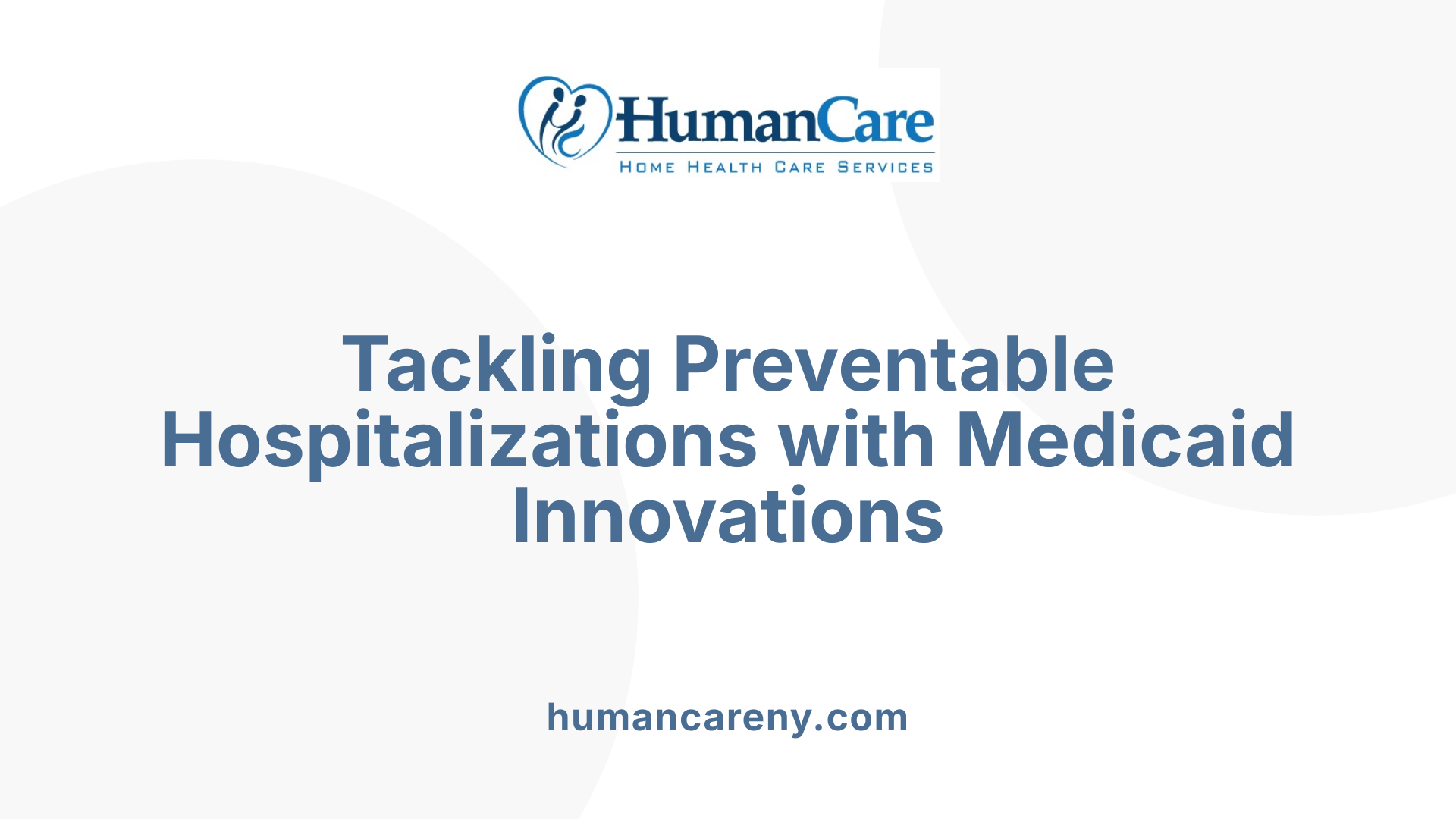Understanding the Impact of Medicaid Waivers on Hospital Readmissions
Medicaid waiver programs play a critical role in shaping healthcare delivery, especially in efforts to reduce avoidable hospital readmissions. By enabling states to test innovative care models, these waivers foster integrated, community-focused, and patient-centered approaches that address both medical and social determinants of health. This article explores how such programs influence hospital outcomes, improve organizational practices, and deliver tangible benefits to vulnerable populations.
Medicaid Waiver Programs and Their Effectiveness in Reducing Readmissions

How do Medicaid waiver programs impact hospital readmission rates?
Medicaid waiver programs play a significant role in decreasing hospital readmission rates by fostering innovative, integrated care approaches. These programs enable states to develop tailored solutions that improve care coordination and expand access to community-based services, crucial for vulnerable populations such as those with chronic illnesses or behavioral health needs.
Through these waivers, states can implement models that emphasize preventive care, social support, and smoother transitions between hospital and home. This focus helps manage chronic conditions effectively outside institutional settings, leading to fewer unnecessary hospitalizations.
Research indicates that Medicaid expansion — often facilitated through these waivers — correlates with reductions in overall hospital readmissions. Studies show a decline of approximately 9 to 18 hospital admissions per 10,000 patients over three years in states that expanded Medicaid, demonstrating the positive impact of broader coverage and enhanced care resources.
While Medicaid waivers may not directly reduce mortality or emergency department visits, their role in supporting preventive and outpatient management of chronic illnesses significantly contributes to lower avoidable readmissions. Increased eligibility for inpatient rehabilitative care, also expanded through these programs, helps improve functional outcomes, further reducing the likelihood of hospital re-admission.
Overall, Medicaid waiver programs are instrumental in advancing hospital quality improvement efforts by integrating health and social services, which ultimately reduces unnecessary hospital stays and promotes better health management.
Examples of successful Medicaid waiver initiatives
Several innovative programs across the country illustrate how Medicaid waivers effectively reduce readmissions. For instance, California’s Whole Person Care program integrated health, behavioral health, and social services to reduce inpatient admissions and emergency visits while supporting housing stability.
In Illinois, extending postpartum Medicaid coverage from 60 days to 12 months led to an increase in postpartum visits and better mental health support for new mothers, which contributes to fewer hospital readmissions related to postpartum complications.
Alaska’s behavioral health waiver expanded access to mental health and substance use disorder treatments, reducing crisis hospitalizations and improving ongoing care for behavioral health needs.
Texas Children’s Hospital adopted a patient-centered medical home model for children with chronic conditions, leading to better disease management and decreased hospitalizations.
These initiatives demonstrate how tailored programs addressing social determinants of health and care continuity can result in measurable reductions in hospital readmissions.
Correlation between Medicaid expansion and reduced hospitalizations
The expansion of Medicaid under the Affordable Care Act, often facilitated through Section 1115 waivers, has shown a notable effect on reducing hospitalizations across various populations.
States that expanded Medicaid coverage report fewer unnecessary hospital admissions, partly due to increased access to outpatient services, preventive care, and social support systems.
Regions implementing regionalized care models and forming multi-stakeholder partnerships—such as New York’s Performing Provider Systems—have experienced success in targeting specific causes of readmissions, including emergency department overuse and inpatient stays.
Funding mechanisms like the Delivery System Reform Incentive Payment (DSRIP) program provide financial incentives based on performance milestones, encouraging continuous improvement in care delivery.
In conclusion, Medicaid waiver initiatives contribute substantially to reducing hospital readmissions by expanding access, supporting preventive care, and fostering innovative collaborations across health and social services. These programs serve as vital tools for achieving overall improvements in healthcare quality and cost containment.
Strategies and Organizational Approaches Enabled by Medicaid Waivers

What mechanisms and strategies are used by Medicaid waiver programs to reduce hospital readmissions?
Medicaid waiver programs deploy a broad range of innovative strategies to lower the rates of hospital readmissions, particularly among vulnerable populations. Central to these efforts is the emphasis on care coordination and transitional services. These programs often involve multidisciplinary teams that manage patient care before, during, and after hospital stays, focusing on seamless transitions and comprehensive discharge planning.
A critical tool used in these initiatives is analytics technology. Predictive analytics and electronic health records (EHRs) allow providers to identify patients at high risk for readmission more accurately. By analyzing data such as health history, social factors, and healthcare utilization patterns, care teams can implement targeted interventions to prevent unnecessary hospital returns.
Addressing social determinants of health (SDOH) such as housing stability, transportation access, and food security is another cornerstone of Medicaid waiver strategies. These are often integrated through community partnerships and support services, recognizing that health outcomes extend beyond clinical care. For example, programs may connect patients with housing assistance, transportation services, or nutritional support to ensure they can adhere to medical recommendations.
Patient education also plays a vital role. Enhancing health literacy through tailored education programs helps patients understand their conditions, medication management, and follow-up requirements, leading to better self-care and reduced readmissions.
In addition, waiver programs promote real-time data sharing and information exchange among providers, enabling quick responses to emerging issues and continuous quality improvement. The creation of community-based approaches allows for more holistic care, integrating social services with medical care.
Furthermore, value-based payment models incentivize organizations to focus on quality outcomes rather than volume, fostering collaborations between hospitals, SNFs, and community providers. These arrangements encourage innovative care models, such as hospital-at-home programs, which have demonstrated success in reducing avoidable hospital stays.
Below is a summary table highlighting the Medicaid waiver strategies:
| Strategy | Implementation Examples | Impact Focus |
|---|---|---|
| Care coordination and transitions | Multidisciplinary teams, post-discharge support | Reduce preventable readmissions |
| Use of predictive analytics | EMR data analysis to identify high-risk patients | Tailored interventions, early detection |
| Addressing social determinants | Community partnerships for housing, transportation | Holistic patient support, improved sustainability |
| Patient education | Tailored health literacy programs | Improved compliance and self-management |
| Data sharing and real-time monitoring | Electronic health record (EHR) integration | Continuous improvement and rapid response |
| Value-based arrangements | Shared savings programs, risk-sharing models | Quality enhancement and cost containment |
Through these strategic frameworks, Medicaid waivers enable healthcare providers to create more responsive, integrated, and patient-centered care systems that effectively diminish the likelihood of avoidable hospital readmissions and improve overall health outcomes.
Role of Medicaid 1115 Waivers in Enhancing Hospital Outcomes

What role do Medicaid waivers, such as 1115 waivers, play in improving hospital outcomes?
Medicaid 1115 waivers are powerful tools that allow states to innovate and tailor healthcare services beyond traditional Medicaid rules. These waivers promote improvements in hospital outcomes by enabling the development of customized programs focused on reducing unnecessary hospitalizations and readmissions.
One of the primary ways they do this is through addressing social determinants of health—factors like housing, transportation, food security, and social support—that significantly influence patient health but are often outside traditional medical care. By integrating services that target these social factors, waivers help create a more holistic approach to health, ultimately decreasing hospital visits and readmissions.
These programs support the expansion of coverage, implement delivery system reforms, and foster pilot projects aimed at specific populations, such as those with chronic conditions, behavioral health needs, or social disadvantages. For example, innovative models like community-based services, managed care, and non-medical support services are all facilitated through these waivers.
States that utilize 1115 waivers often highlight transparency, stakeholder engagement, and continuous evaluation, which ensure that the programs meet their goals of improving health outcomes. Successful examples include California’s Whole Person Care and Illinois’ extended postpartum Medicaid coverage, both of which have shown reductions in hospital admissions while increasing access to comprehensive care.
Furthermore, these waivers encourage regionalization efforts and partnerships that leverage local resources and population data to improve care coordination.
Examples of state-level programs and their achievements
| State | Program Name | Achievements | Impact on Hospital Outcomes | Key Strategies |
|---|---|---|---|---|
| California | Whole Person Care | Reduced inpatient admissions, emergency visits, improved housing stability | Significant decrease in hospital utilization | Integrated care, housing support, and community health networks |
| Illinois | Postpartum Medicaid Extension | Increased postpartum care visits, mental health support | Lower readmission rates, better maternal health | Extended coverage through 12 months, enhanced care coordination |
| Alaska | Behavioral Health Waiver | Increased access to mental health and SUD treatments, reduced crisis hospitalizations | Fewer emergency episodes, improved mental health outcomes | Community care coordination, integration of behavioral health services |
How Medicaid 1115 waivers contribute to hospital improvement
| Aspect | Details | Resulting Benefits | Example Projects |
|---|---|---|---|
| Innovation | Applying successful practices from other regions or populations | Tailored approaches that directly target local needs | California’s Whole Person Care, Illinois maternal health programs |
| Service Expansion | Broader service delivery including social needs | Reduced hospital admissions and readmissions | Managed care, social support services |
| Financing | Uses pooled funds and performance incentives | Sustainability and accountability | DSRIP programs, regional partnerships |
By focusing on comprehensive, patient-centered care that includes social, behavioral, and medical services, Medicaid 1115 waivers effectively enhance hospital performance. This results in fewer unnecessary hospital stays, better health outcomes, and more efficient use of healthcare resources.
Broader impacts on health equity and system efficiency
Addressing social determinants and implementing innovative care models reduce disparities among vulnerable populations. These efforts also help hospitals meet quality benchmarks and avoid penalties linked to readmission rates.
In summary, Medicaid 1115 waivers are essential in transforming care delivery through innovative, integrated approaches. They focus on reducing avoidable hospital utilization by addressing root causes and expanding support systems, ultimately leading to healthier communities and more sustainable healthcare systems.
Preventable Hospitalizations and the Role of Medicaid Waivers

How effective are Medicaid waiver programs in decreasing preventable hospitalizations?
Medicaid waiver programs have proven to be a significant force in reducing preventable hospital admissions. These programs are designed to enhance access to timely, appropriate outpatient and primary care services, particularly benefiting vulnerable populations such as residents in long-term care facilities and individuals living in rural or underserved areas.
One notable example is the CMS-supported initiative aimed at nursing facility residents. This program employed evidence-based interventions, including deploying on-site clinical staff and providing comprehensive staff training. The results were promising, with marked decreases in inpatient hospitalizations, emergency department visits, and related Medicare costs. Such targeted approaches underscore the importance of proactive care management and enhanced clinical support at the community level.
State-led programs also contribute significantly to this effort. For example, Tennessee’s TennCare Shared Savings and Missouri’s ToRCH initiative focus on addressing social determinants of health—like housing, nutrition, and transportation—that often influence health outcomes. These programs aim to improve care integration across medical, behavioral, social, and community services, which further helps in preventing unnecessary hospitalizations.
Research findings reinforce the effectiveness of Medicaid expansion under the Affordable Care Act (ACA). Data indicates that such expansion correlates with declines in hospitalizations for conditions sensitive to outpatient care, improved management of chronic diseases, and increased access to preventive services. These improvements collectively lead to fewer emergency visits and hospital stays that could often be avoided with better preventive and outpatient care.
Altogether, diverse Medicaid waiver programs and policy initiatives—ranging from targeted care models to broader expansion efforts—work synergistically to reduce preventable hospitalizations. They also contribute to elevating healthcare quality, especially for low-income, high-risk, or historically underserved populations.
| Program/Study | Approach | Impact | Additional Details |
|---|---|---|---|
| CMS nursing facility initiative | On-site staff, clinical training | Reduced hospital admissions and costs | Focused on direct clinical support in long-term care settings |
| TennCare Shared Savings | Addressing social factors, care integration | Improved health outcomes | Emphasized social determinants and comprehensive care coordination |
| Missouri’s ToRCH | Community-based interventions | Fewer hospitalizations | Tailored to rural and underserved populations |
| ACA Medicaid expansion | Coverage increase | Lowered hospitalizations for sensitive conditions | Enhanced preventive care access |
Understanding the collective influence of these programs highlights the importance of innovative policy and community-focused strategies in promoting sustainable, high-quality healthcare while minimizing avoidable hospital stays.
Organizational Strategies and Care Transition Interventions Supported by Medicaid
How do organizational approaches and care transitions through Medicaid programs help lower hospital readmission rates?
Medicaid programs play a pivotal role in reducing hospital readmissions by supporting a range of organizational strategies focused on improving care transitions and community partnerships. Central to these efforts is care coordination, which involves synchronizing services across multiple providers to ensure seamless patient care both during and after hospitalization.
One effective approach encouraged by Medicaid is transitional care management. This includes structured discharge planning, timely follow-up visits, and comprehensive patient education. These interventions help address medication management issues, clarify care plans, and ensure patients are connected with outpatient providers promptly.
Another critical component is establishing community-based partnerships. For example, Medicaid waivers enable states to introduce innovative programs such as community health worker initiatives and patient navigation services. These programs focus on social determinants of health—like housing, transportation, and food security—factors that significantly influence readmission risk.
Care programs that emphasize team-based approaches involve multidisciplinary teams including nurses, social workers, and primary care providers. They work together to identify at-risk patients early, develop personalized care plans, and maintain regular contact through phone calls or telehealth visits.
Data sharing plays an essential role in these strategies. Medicaid-funded initiatives often leverage electronic health records (EHRs) to flag patients at high risk, facilitate real-time communication among providers, and monitor adherence to care plans.
Successful models also include post-discharge follow-ups within a week, home visits, and community support groups. These efforts reinforce self-management skills and allow prompt intervention if complications or barriers to care arise.
By aligning financial incentives through Medicaid waivers and demonstration projects, providers are encouraged to adopt these best practices consistently. Overall, these organizational strategies supported by Medicaid foster a healthcare environment where patient-centered, coordinated care reduces unnecessary hospital stays and readmissions.
Use of Technology for Monitoring and Intervention
Technology integration is a cornerstone of modern care transition efforts. Medicaid programs increasingly rely on electronic health records and predictive analytics to identify patients at high risk of readmission.
EHRs facilitate communication and ensure that all providers have access to up-to-date patient information, including medications, allergies, and recent hospitalizations. This comprehensive data sharing promotes informed decision-making and timely interventions.
Predictive analytics, often based on EHR data, help stratify patients by readmission risk. By applying algorithms that analyze factors such as age, comorbidities, social determinants, and previous admissions, healthcare teams can prioritize interventions for those most likely to benefit.
Remote monitoring tools, including telehealth platforms and wearable devices, enable continuous oversight of patient health status post-discharge. These allow providers to detect early signs of deterioration and intervene before hospitalization becomes necessary.
Moreover, some Medicaid-supported programs incorporate automated alert systems that notify care teams of missed appointments or worsening symptoms, prompting proactive outreach.
Mobile applications and patient portals also empower patients to participate actively in their care. Features may include medication reminders, symptom trackers, and direct communication channels with healthcare providers.
Overall, leveraging technology enhances the effectiveness of care transition interventions, ensuring that at-risk populations receive timely, coordinated, and personalized support aimed at reducing readmission rates.
| Strategy Area | Key Technologies | Impact on Readmissions | Example Initiatives |
|---|---|---|---|
| Care coordination & discharge planning | Electronic Health Records (EHRs), care management platforms | Enhanced communication, accurate follow-up | California’s Whole Person Care, NMC’s care transition program |
| Monitoring & interventions | Telehealth, remote monitoring devices, predictive analytics | Early detection of deterioration, personalized risk stratification | Northwestern Medical Center’s use of EMR, CMS pilot programs |
| Community engagement | Mobile apps, patient portals, community health worker apps | Increased patient engagement, adherence to care plans | Bluebonnet Trails Community Services’ navigation project |
These integrated strategies and technological tools exemplify how Medicaid programs aim to transform care delivery, making it more effective in preventing readmissions and improving overall population health.
Hospital Policies and Practices Influenced by Medicaid Waiver Programs
In what ways do Medicaid waiver programs influence hospital policies and practices to reduce readmissions?
Medicaid waiver programs have become a vital tool in reshaping hospital policies and practices with the aim of reducing avoidable readmissions. These programs promote comprehensive care coordination, enhance quality improvement initiatives, and support transitional care strategies that directly target the risk factors associated with hospital readmissions.
One significant influence is the encouragement of hospitals to adopt advanced data analytics, electronic health records (EHR), and predictive modeling tools. These technologies allow healthcare providers to identify high-risk patients more effectively, enabling tailored interventions that can prevent unnecessary readmissions. For example, by analyzing factors such as social determinants of health—like transportation barriers, housing insecurity, or health literacy—hospitals can develop targeted plans that address underlying issues contributing to repeated hospitalizations.
Furthermore, Medicaid waivers incentivize hospitals to forge stronger community partnerships. Collaborations with community-based organizations, social services, and primary care providers are prioritized to create a more integrated approach to patient care. Such partnerships facilitate smoother care transitions from hospital to home or community settings, which is crucial in minimizing avoidable readmissions.
However, despite these positive influences, certain policy limitations pose challenges. Restrictive Medicaid policies, including work requirements or coverage gaps, can interrupt ongoing care and reduce patients’ access to necessary preventive services. These policy gaps may hinder the continuity of care that is essential for preventing hospital readmissions.
Overall, Medicaid waivers guide hospitals toward value-based and community-oriented care models. They emphasize the importance of addressing social determinants and leveraging technology to improve patient outcomes. Nonetheless, persistent policy restrictions and socioeconomic barriers continue to limit the full potential of these strategies.
Implementation of data analytics, quality improvement practices, and community partnerships
| Practice Area | Description | Impact on Readmission Reduction | Challenges |
|---|---|---|---|
| Data Analytics & Predictive Modeling | Hospitals analyze patient data to identify those at high risk of readmission | Enables targeted interventions, improves risk stratification | Data privacy concerns, need for technological infrastructure |
| Quality Improvement Initiatives | Programs such as care transitions and medication reconciliation | Reduce errors and optimize discharge planning | Staff training requirements, resource allocation |
| Community Partnerships | Collaborations with social services, housing, transportation | Address social determinants, support post-discharge care | Coordination complexity, funding limitations |
| Use of Electronic Health Records | Enhancing communication and real-time data sharing | Supports timely follow-up and monitoring | Interoperability issues, data management challenges |
Challenges and Policy Limitations
While Medicaid waivers promote innovative practices, policy limitations such as lack of uniform implementation standards, funding constraints, or restrictive eligibility criteria can hinder progress. Coverage gaps, work requirements, and limited access to certain services also threaten the sustainability of these initiatives.
Many hospitals face operational hurdles in integrating community-based services and technological solutions, especially in underserved regions. Overcoming socioeconomic barriers requires coordinated policy efforts that go beyond hospital walls.
In conclusion, Medicaid waiver programs have significantly influenced hospital policies by fostering a focus on care coordination, data-driven practices, and community engagement. Yet, addressing policy limitations and socioeconomic challenges remains essential to fully realize the potential of these programs in reducing hospital readmissions.
Toward a Future of Reduced Readmissions and Improved Outcomes
Medicaid waiver programs represent a vital component of the broader strategy to reduce hospital readmissions. By enabling innovative, integrated care models, fostering cross-sector partnerships, and emphasizing social determinants of health, these programs help hospitals and communities deliver more effective, patient-centered care. The success stories from various states showcase the potential for these approaches to generate substantial cost savings while improving health outcomes for vulnerable populations. Continued policy support, technological advancements, and collaborative efforts will be essential to sustain these gains and advance towards a healthcare system focused on quality, efficiency, and equity.
References
- Hospital Readmissions Reduction Program
- The Hospital Guide to Reducing Medicaid Readmissions
- How Health Plans Can Succeed in 1115 Medicaid Waiver ...
- The Crucial Role of Skilled Nursing Facilities in Reducing ...
- Strategies to Reduce Hospital Readmission Rates in a Non ...
- Home-recovery program leads to 44% reduction in ...
- What-Every-Health-Care-Leader-Should-Know-About- ...



